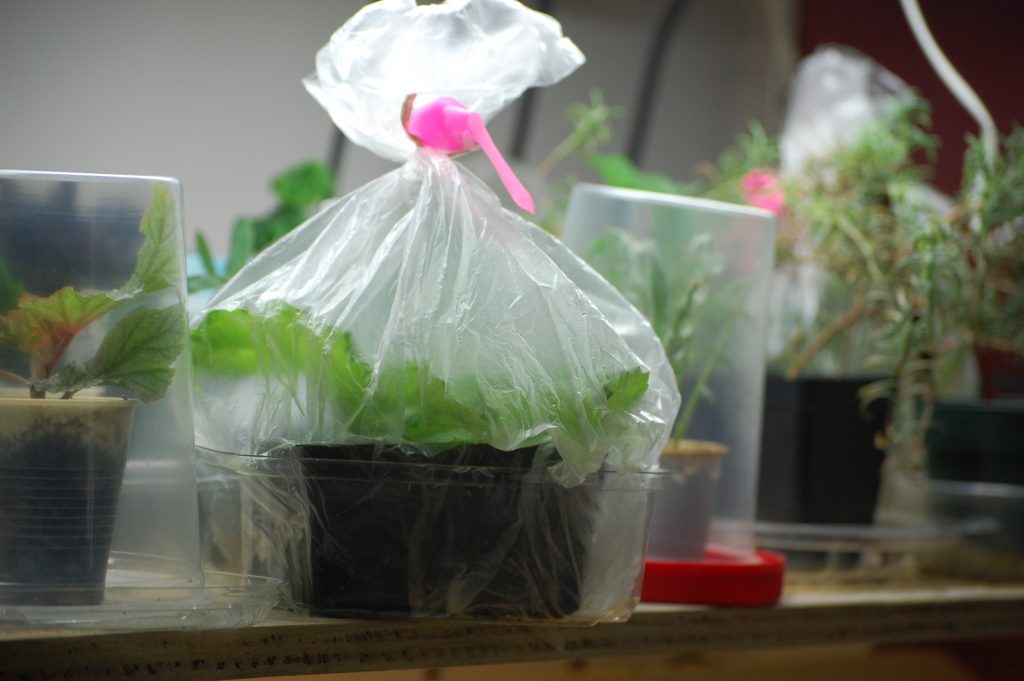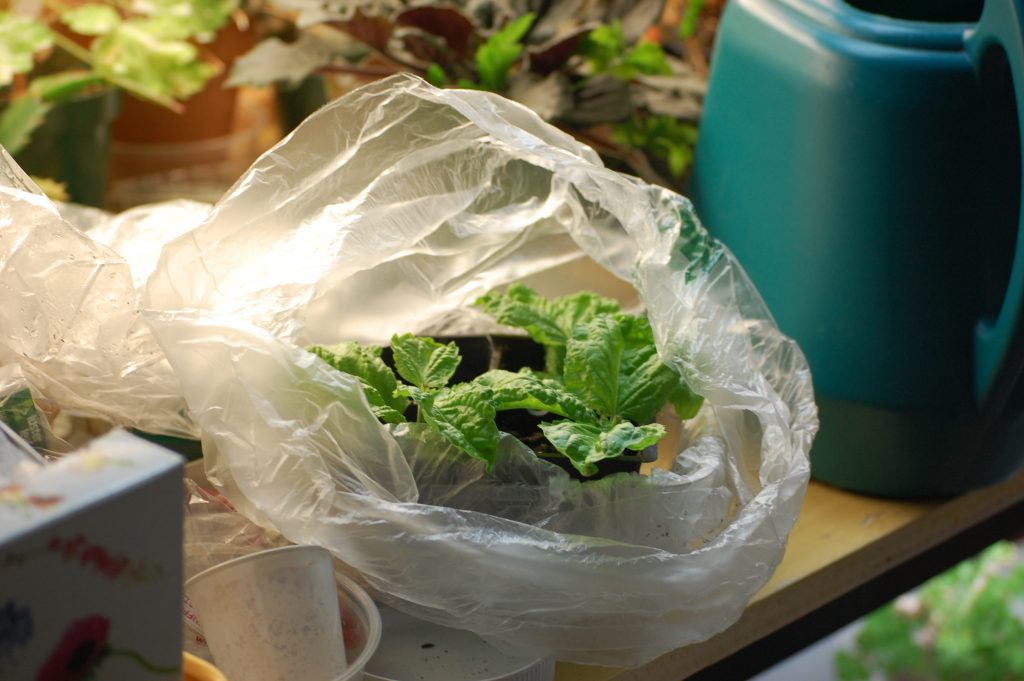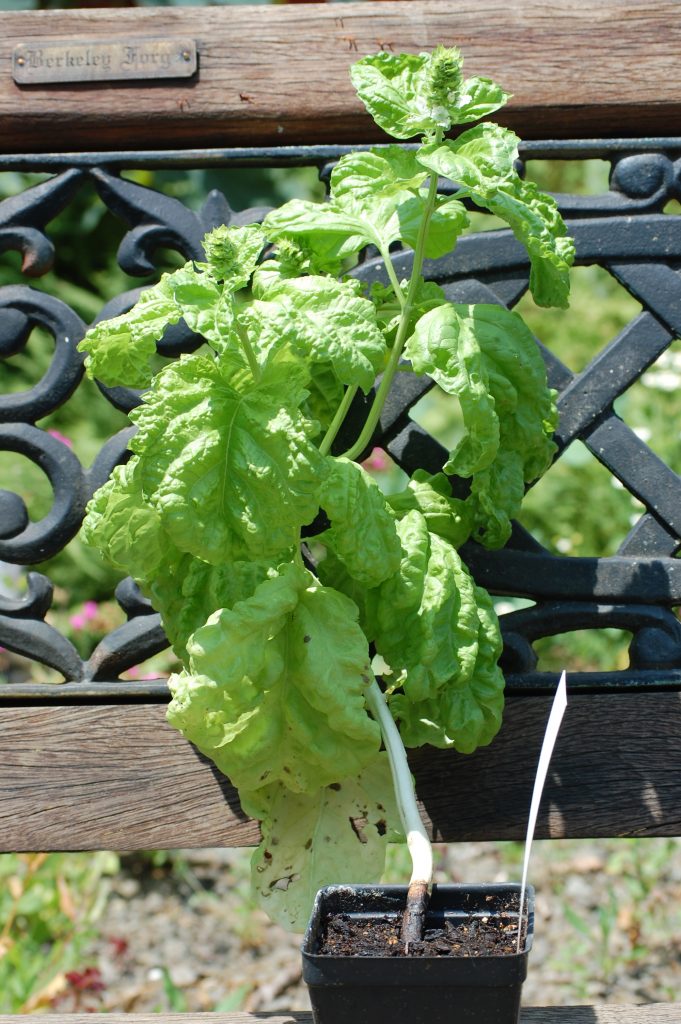Add slices of lemon and cucumber to water to create cucumber water. Add fresh basil for some added flare. Or try lemons and limes in water with a sprig of rosemary. – Bev
Thymely Tips
-
Refreshing Drink
-
Potatoes with Rosemary and Lavender
Bev shares a favorite recipe using Yukon potatoes. Take small Yukon potatoes. Cut in half and drizzle with olive oil. Spread out on a lined cookie sheet. Sprinkle with sea salt and pepper. Then chop fine rosemary and dried lavender. Sprinkle on potatoes. Bake at 350 degrees until soft and golden. Bev uses dried lavender flowers not only for flavor but for presentation. – Bev
-
Harvesting Basil
Probably by now you have plants with enough leaves to harvest without hurting the plant. One way is to strip off leaves individually from 1/3 of the plant, another is to simply cut back the plant by 1/3. What remains will continue to grow and produce more leaves, especially if you add a little fertilizer after pruning.
Basil is one herb that doesn’t keep its flavor well when dried. Freezing is probably the best choice. I like to lay the plant material to be frozen on some plastic wrap in a shallow layer, cover with another layer of plastic wrap or roll up. Mash the packet flat, place in plastic freezer bag, squeezing out all the air, and freeze.
So your recipe calls for a cup of loosely packed basil leaves and here you are with this frozen mass. What to do? Before you freeze the basil loosely pack a measuring cup with leaves and weigh on your kitchen scale. When I did this I got .3 ounces. I taped a note saying just that to the inside of a cupboard door. The next time I need that loosely packed cup of basil leaves I can just open the cupboard to see how much that would weigh and get out my handy kitchen scale and the frozen basil. Problem solved. – Sandy
-
Keeping Your Containers Moist
Keeping your container plants moist is quite the challenge when temps are in the 90s and high 80s. Sometimes they need watered twice a day and if you’ve been gone all day the potting medium can dry out more than you’d like. Once it is completely dry or nearly so, it can be hard to have water soak in. One way to accomplish this is to water the pot, wait a few minutes, water again, and repeat until the medium has absorbed enough water. Gently spraying the pots in that container will help them rehydrate. Another method to rehydrate a container is to set it in a pan of water so that it is continually absorbing water from the bottom. I like to keep a kitty litter container outside that I can put a couple inches of water in for just this purpose. It works great for any size pot from 4″ on up. The other day I noticed little wiggly thingies in the water and recognized them to be mosquito larvae. Since breeding mosquitos wasn’t my objective I poured that water out on some containers where the water would quickly dry up and the larvae perish. So be aware of the possibility of mosquitos trying to create more mosquitos and don’t leave the water standing in any container too long. Another option is to put a little bit of a ‘mosquito dunk’ in the standing water. Mosquito dunks contain larvicides in the form of BT that will stop the larvae from developing and are great for bird baths or other water containers not changed regularly. Hope these ideas help. – Sandy
-
Five Tips for Successful Growing
Niole has several tips to help you have success with growing your herbs.
- Pick the right spot for the best growth. Herbs prefer a good amount of sunlight, approximately six hours per day or more; however, chives, lemon balm, mint and parsley can be more shade tolerant than other herbs.
- Although herbs require minimal maintenance, show them some tender, loving care. Give herbs proper space when planting to improve airflow, grow sturdier stems, and prevent diseases. Provide loose, well-draining soil to help water get to the roots.
- Water smartly (not to much or too little) for success. Check the soil a couple of inches below the surface and water if dry. However if your herbs are recently transplanted or still young they may not have a well developed root system and will require water sooner. Soak the soil each time. This encourages the plant to develop a deep root system which will not need watered as frequently.
- Container planted herbs may dry out quicker than plants grown in the garden. As they get bigger they will need watered more frequently. And again, soak the soil.
- Refer to the post on aggressive herbs to help with closing the correct place to plant those. – Nicole
-
Basil Cuttings
I took cuttings from the three stems on the purchased lettuce leaf basil plant. Always use a sharp knife or pruners to take a cutting. You don’t want to bruise the end you are inserting in the moist potting soil. You can also use sand to root cuttings. The photo on the left shows the cuttings enclosed in a plastic bag and tied shut. The pink piece of flagging tells me that this plant has been growing outside and/or at a nursery and might have some insect eggs on a leaf that I don’t want to bring into my light garden. So I’ll take it outside when I want to open the bag and check on the cuttings. The photo on the right shows the three cuttings safely tucked into a four-compartment market pack. Putting each cutting in its own compartment will make for easier transplanting later. In about a week they will be ready to move into a sheltered spot outdoors and gradually exposed to less humidity. Sunlight will come later. I’ll keep the new plants shaded until they are have a good root system. Then I’ll gradually expose them to more light. If these plants had never been outdoors and exposed to insects, I would not move them outside so quickly. I would open the plastic bag and gradually accustom them to less humidity eventually removing the bag entirely while keeping them under the grow lights. -Sandy


-
More Lettuce Leaf Basil
Here’s a photo of a good sized lettuce leaf basil plant I recently purchased at a local nursery. You can see it has several stems I can take cuttings from.

-
Delicious Sandwich with Basil
Here’s a great way to use your basil. You’ll need some mesquite smoked turkey breast lunch meat, mayo, basil, parmesan cheese, and chopped roasted walnuts. Toast the inside of two slices of Italian bread. Place turkey breast on one slice. Spread the other with mayonnaise. Sprinkle with parmesan cheese, the chopped basil (enough to cover the bread slice), and some chopped roasted walnuts. You can add lettuce and a slice of tomato if you like. Put the two slices together. I prefer at this point to toast the outside of the sandwich under the broiler or in a skillet. You can sprinkle in a bit of oat bran for fiber. It’s a bit messy to eat as the walnut pieces want to keep falling out but it is worth the bother. Delicious.
-Sandy
-
Lettuce Leaf Basil
This is one of my favorite basils. The large leaves mean the plant can put on enormous growth quickly. Some folks have a particular variety they prefer for flavor. I’ve never been too particular; I love them all. But in my mind for freezing basil, for accumulating enough for pesto, you can’t beat lettuce leaf basil. The leaves are easy to strip from the stalk since you are dealing with fewer large leaves. Mammoth leaf basil is another large leaved variety to try. These large leaved varieties are harder to find at a garden center so getting seeds is probably a must. A mail order catalog is sure to have them if you can’t find them locally. For earlier production start the seeds indoors four to six weeks before planing outdoors. But if your aim is to freeze basil for winter use then planting the seeds directly in the garden when the soil has warmed up is less bother.
-Sandy
-
More Basil
It’s late June and you realize you don’t have enough basil planted. There aren’t many plants left at the garden stores and even if there were, they cost more than you want to spend. The solution? Take cuttings of your already existing basil. In a pinch you can even buy a basil plant in the grocery store or maybe try just basil as a packaged herb. I’ve done it when I wanted a basil plant for indoors in the winter. Refer to the tip “Take a Cutting” from a May thymely tip for details on how to take a cutting and root it. Basil is quick to root and grows quickly. A dilute solution of fertilizer used when watering will encourage it to grow. When planting the hardened-off plant use slow release granular fertilizer to encourage growth.
-Sandy
